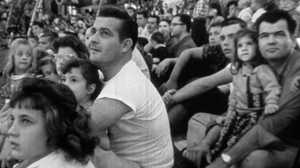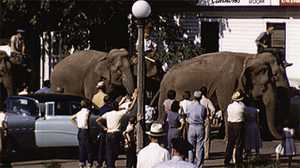Animal Welfare and the Circus: The Jack London Club
By Janet M. Davis

In 1917, the publication of a posthumous novel captivated American animal welfare activists. Written by Jack London shortly before he died, Michael, Brother of Jerry told the harrowing story of a terrier who was kidnapped and trained by threat of force to sing on the vaudeville stage. Reverend Francis Rowley, president of the Massachusetts Society for the Prevention of Cruelty to Animals (MSPCA), was so moved by the novel that he created a new organization in London’s memory. The Jack London Club strove to ban performing animal shows through a singular strategy: the walk out. Thousands of people joined the club each month by mailing a letter to the MSPCA headquarters in Boston, which included a written pledge to walk out of any animal amusement.
As the nation’s first organization dedicated to banning performing animals, the Jack London Club heralded a new strand of modern American thought about animals and their place in the world. Before the club’s founding, the oldest animal welfare societies, such as the American Society for the Prevention of Cruelty to Animals (ASPCA) (1866) and the MSPCA (1868), focused on passing legislation to prevent physical suffering and neglect among laboring livestock and food animals. The Jack London Club objected to not only the mistreatment of animals but training them for entertainment rather than allowing them to live apart from humanity in the wild. This would have far-reaching repercussions for the most popular entertainment of the early 20th century — the circus.

There were multiple reasons for this new way of thinking. The nation’s shift from muscle power to motorization was a major one. With the rise of the automobile and the collapse of global equine markets after the Armistice of 1918, the nation’s laboring horse population plunged. The Darwinian revolution meanwhile brought about new social attitudes regarding animal sentience and intelligence—which animal trainers and protectionists alike readily recognized. Motion pictures and photographic journalism were reaching mass audiences with depictions of wild animals in their native environments, which helped solidify modern ideas about wilderness as a pristine place apart from the built environment.
Before the Jack London Club, animal welfare advocates confronted showmen only when they suspected that performing animals experienced physical pain. Most famously, in 1880, Henry Bergh, the president of the ASPCA, held a spectacular showdown with P. T. Barnum at Madison Square Garden in front of thousands of circusgoers. Bergh had been troubled by reports that Barnum’s “fire horse,” Salamander, suffered when jumping through rings of fire. Bergh and twenty-seven officers showed up at the circus to arrest Barnum on cruelty charges. But Barnum outfoxed them. He set the hoops aflame and personally jumped through them, followed by a dozen clowns, thus showing Bergh that the act was not physically painful. Bergh capitulated, and he and Barnum became friends. Barnum became the vice-president of the Bridgeport SPCA and proudly called himself the “Bergh of Bridgeport.” He joined the ASPCA, left a generous gift to the organization in his will, and he donated one thousand dollars to the City of Bridgeport to build a statue in Bergh’s honor.

The Jack London Club marked the end of the cordial relationship between the circus and animal welfare advocates. Emboldened by the Club’s membership growth of over 24,000 in its first year, the MSPCA sponsored a bill in the Massachusetts legislature to ban performing animal shows statewide, but the bill omitted the circus. Francis Rowley reasoned that activists should “get half a loaf now if we can” instead of risking everything in a direct confrontation with the circus. Still, the bill proved cause for concern under the big top. On March 6, 1920, John M. Kelley, general counsel for the Ringling Bros. and Barnum & Bailey Circus, appeared before the Legislative Committee on Legal Affairs in Boston to express his objections: if the bill became law, the nation’s largest circus would surely cease.
Though the bill failed, concern at Ringling Bros. only grew. In light of the continued expansion of the Jack London Club, Kelley’s boss, John Ringling, took preemptive action in 1925 and banned big cat acts at his circus—the same year that Parliament passed a law to regulate performing animal shows in Great Britain. Ringling disliked cat acts, or “cage acts,” because they were staged in heavy barred enclosures that were difficult to transport. But the animal welfare activists’ biggest win to date would prove temporary: When Ringling bought more circuses in 1929, he kept their cage acts and eventually brought them back to the Big Show, as well. Animal performances continued in circuses throughout the rest of the 20th century.
In the 21st century, however, a broad contingent of animal welfare groups has succeeded in passing full or partial bans of animal performances in 81 municipalities in 29 states as well as in many locations abroad. In May 2017, embattled show owner Kenneth Feld closed the Ringling Bros. and Barnum & Bailey Circus forever. A handful of shows still contain exotic animals, most notably the highly popular UniverSoul Circus. But Cirque du Soleil, a Canadian import and America's most profitable circus, is animal-free—a major selling point today and a point of irony for its founders, who wanted to include animals in their first show in 1984 but could not afford them. Instead, they found a new way to evoke the beauty and power of animals: Cirque du Soleil is full of animalized human performers who artfully recreate the kinetics of feline pouncing and avian flight for those modern audiences who yearn to see animals in the wild, rather than in the ring.

Janet M. Davis is Distinguished Teaching Professor of American Studies and History at the University of Texas at Austin, where she also serves as Associate Director of the Plan II Honors Program. Her most recent book is The Gospel of Kindness: Animal Welfare and the Making of Modern America (Oxford University Press, 2016), which won the 2018 President’s Book Prize from the Society for Historians of the Gilded Age and Progressive Era, as well as an Outstanding Title Award from Choice in 2017.







